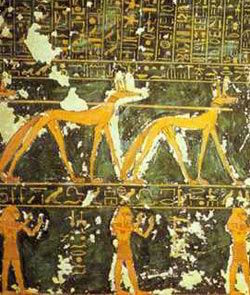
The discovery wasn’t a “one off.”
In 1935, Dr. George Reisner lead the Harvard-Boston Expedition in exploring a great cemetery west of the pyramid of Khufu at Giza. They found a 5th Dynasty inscription in the tomb of Antefaa II that had recorded the burial of a dog named, “Abuwtiyuw.” When translated, it read: “The dog which was the guard of his Majesty, Abywtiyuw is his name. His Majesty ordered that he be buried ceremonially, that he be given a coffin from the royal treasury, fine linen in great quantity, and incense. His Majesty gave perfumed ointment and ordered that a tomb be built for him by the masons. His Majesty did this for him in order that the dog might be honored before the Great God. In this way, the king ensured that his favorite hound would enter the afterlife and be waiting for him to continue his attendance when the king died.” With the inscribed text was a drawing of the dog which today we know as the Pharaoh Hound. As an aside, the image appears as the logo for the Pharaoh Hound Club in the UK.
And then came Professor W. B. Emery who worked on the excavation of the great mastaba tomb of Queen Her-Neith at Saqqara in the 1950s. He discovered the remains of a hunting dog buried at the threshold of the tomb of Her-Neith believed to be the wife of the Pharaoh Djer, and it resembled the dog that Reisner had found: A prick eared hunting dog with a long, lean head, lithe body, and a whip-like tail.
Beautiful Egyptian tomb paintings depicted these dogs, and our thumbnail image shows a detail of such a painting. You can see the full image here (and even purchase it).
If the visuals weren’t enough to be persuasive that these dogs were Pharaoh Hounds, then a 19th century translation of what had been written in hieroglyphics in the Eleventh Dynasty would be: “The red long-tailed dog goes at night into the stalls of the hills. He is better than the long—faced dog. He makes no delay in hunting, his face glows like a god and he delights to do this work.”
A face that “glows like a god” most certainly referred to the signature “blushing” trait still exists in the Pharaoh Hound.

There is no evidence the ancient Egyptian dog, the Tesem, is related to the modern Pharaoh Hound. On the contrary the genetics say that this breed of Malta is no more than 100 years old. Historical records refer to Cirneco Etneo breeders on Malta in the 17th century. From these, through crosses with other dogs, the Pharaoh Hound was born.
Furthermore, the original breed probably became extinct around the 18th century BC. when the ancient Egyptians stopped representing it.
Thanks for the comment, Giovanni. We’re puzzled by why you think we suggested that the Tesem is related to the modern Pharaoh Hound since we don’t mention it in the article. Also, neither the FCI, AKC, nor any parent club that our Pharaoh Hound experts (long time owners and breeders) know of have accepted any alternative to the 3500+ year story, and until they do, that’s the accepted lore we run with. The general consensus at this time among those governing bodies is that the Pharaoh Hound is one of the oldest breeds, and until we learn otherwise from them, we’ll stand by the original post. It’s always good to have discussion and additional input, however, and we appreciate the time you took to share your comment – and that terrific photograph, with us!
No two pharaoh breeds agree on origin
I read your answer only now after months. I reply, many kennel clubs and dogs associations are rather reluctant to scientific truths, especially genetic ones. Even today many classify dogs according to 19th century guidelines (for example ‘Canis palustris’ or ‘Canis matris optimae’) which have proved unfounded following scientific progress.
You are free to manage your blog as you see fit, but maybe a more correct information would make it cooler.
The kelb tal-fenek (or, if you prefer, Pharaoh Hound) is a breed born in the last century as a result of crossings between Cirneco dell’Etna and some other unknown breed (probably Spanish hounds). Prior to this on the island of Malta there were only Etna Hounds.